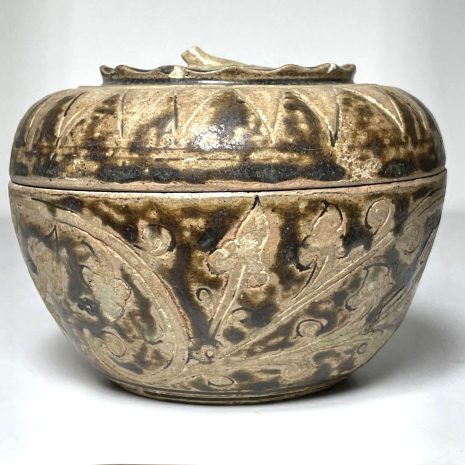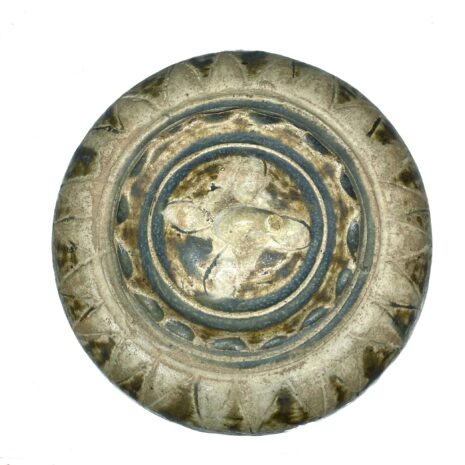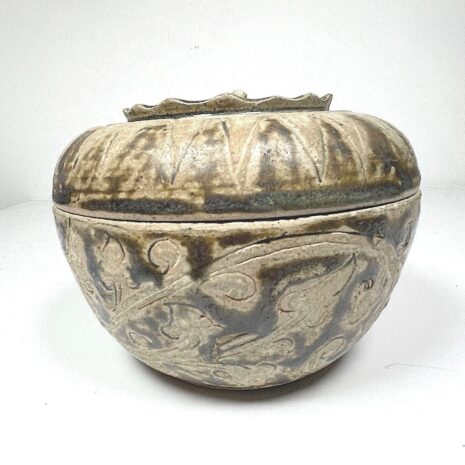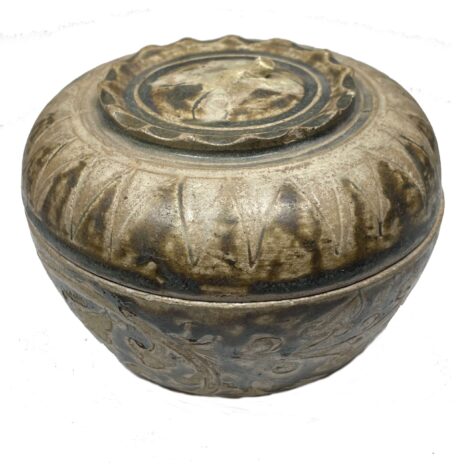Antique Sawankhalok Lidded Bowl, Fruit Stem Handle, Thailand #3170
Original price was: $385.00.$325.00Current price is: $325.00.
Ht: 3.375” Dia: 4.625” | FREE SHIPPING within continental U.S.
Sawankhalok elegant mangosteen shape stoneware lidded bowl with raised calyx, cream and brown glazes, incised floral and geometric designs to store spices, cosmetics, betel nuts and medicine.
Description
Sawankhalok in north-central Thailand is an area that had a large ceramic kiln production during the Sukhothai Kingdom (1238-1583). When Ming emperors forbade export of Chinese ceramics from 1368-1487, known as the Ming Gap, Thailand became a major ceramics producer and exporter to Southeast Asia, Japan and the Middle East. During the 14th and 15th centuries, Sawankhalok kilns created a large range of shapes and glazes including many of unique creations. Stoneware lidded boxes were considered signs of wealth for Thais and overseas owners. Used to store spices, cosmetics, betel nut paraphernalia, medicine and more, they were ancestral pieces sometimes found buried with the deceased for use in the afterlife. Round shapes, lotus bud handles and floral design motifs were adopted from Hindu and Buddhist reliquaries and architectural elements. The most famous and prized ceramics of this period included stoneware with a glaze and celadons recognized for their high quality and beauty. This bowl has two minor chips on the inside rim and the Thai collector who owned this piece wrote “Sangkalok”, the piece’s dating and the number 32 on the bottom in pencil. It has a clear glaze and a subtle green hue covering much of the bowl’s interior. This charm of this 14/15th century stoneware Sawankhalok lidded jar is its elegant mangosteen shape, the use of alternating vibrant cream and brown glazes and stylized incised floral and geometric designs. The lid has a curved stem handle and a round raised calyx, a circle of radiating leaf-like projections that protects a developing flower and represents a mangosteen, the delicious sweet tropical fruit loved throughout Southeast Asia. Concentric raised circles surround the calyx and the body is decorated with a band of incised vegetal scrolls. The distinctive local Thai design is unique in the history of ceramic making. Click here to see the vast array of Thai ceramics and similar Sawankhalok lidded Bowls in the famous Powerhouse Digital Archive Collection.
Sources:
Roxanna Maude Brown, The Ming Gap and Shipwreck Ceramics in Southeast Asia: Towards a Chronology of Thai Trade Ware, Bangkok, Siam Society, 2009.
Louise Allison Cort with George Ashley Williams IV and David P. Rehfuss, “Ceramics in Mainland and Southeast Asia, National Museum of Asian Art,” Collections in the Freer Gallery of Art,
Tom Harrison, “Ming Gap and Kota Batu, Brunei,” The Sarawak Museum Journal, New Series 8(11)/Old Series (26), pp. 273-77, 1958.
University of Michigan Museum of Art, “Sawankhalok Ware Covered Box with a conch handle, a band of stars, and vegetal school design.
Yew Seng Tai, “Ming Gap and the Revival of Commercial Production of Blue and White Porcelain in China,” Beijing, School of Archaeology and Museology, Peking University, Vol. 31, 2011.
Additional information
| Weight | 4 lbs |
|---|---|
| Dimensions | 12 × 9 × 6 in |
| Place of Origin | Thailand |
| Period | Antique, Sukhothai Kingdom |
| Date | 14-15th Century |
| Materials and Technique | Stoneware |
| Dimensions (inches) | Ht: 3.3751"Dia: 4.6251" |
| Dimensions (metric) | Ht: 8.571cm Dia: 1.751cm |
| Weight | 14.3oz |
| Condition | Very good, see description |
| Item Number | 3170BLE |
| Shipping Box Size |








